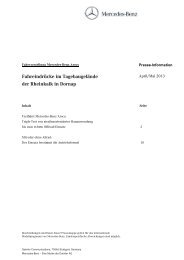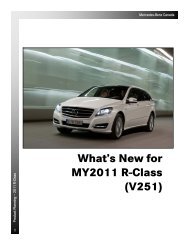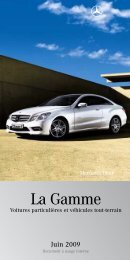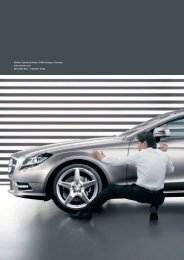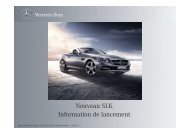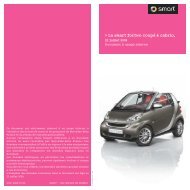Mercedes-Benz S-Klasse INTELLIGENT DRIVE fährt autonom auf ...
Mercedes-Benz S-Klasse INTELLIGENT DRIVE fährt autonom auf ...
Mercedes-Benz S-Klasse INTELLIGENT DRIVE fährt autonom auf ...
Create successful ePaper yourself
Turn your PDF publications into a flip-book with our unique Google optimized e-Paper software.
Challenges on the path to <strong>autonom</strong>ous driving<br />
Page 8<br />
Before the goal of highly and fully <strong>autonom</strong>ous driving is achieved, the obstacles<br />
to be overcome will not be just of a technical nature. Many of the things that are<br />
already technically feasible are still not universally permitted.<br />
For instance, international UN/ECE Regulation R 79 (steering systems) allows<br />
only corrective steering functions, but not automatic steering at speeds above 10<br />
km/h. Under the Vienna Road Traffic Convention, which is relevant for EU law,<br />
the driver must be in constant control of their vehicle and be capable of<br />
intervening at all times. As <strong>autonom</strong>ous vehicles were still out of the question at<br />
the time this convention was adopted, clarification is needed with regard to what<br />
this means for highly or fully automated vehicles. In some US states such as<br />
Nevada, there has already been such clarification, at least as far as the trial<br />
operation of <strong>autonom</strong>ous vehicles is concerned. Another prerequisite for the<br />
transition from partially to highly automated systems is their acceptance in<br />
society. Just as when the automobile was originally invented, it will first of all be<br />
necessary to build up confidence in the technical capabilities of the systems.<br />
This is borne out by a recent study carried out by the Customer Research Centre<br />
at <strong>Mercedes</strong>-<strong>Benz</strong> involving around 100 test persons aged between 18 and 60.<br />
The initial scepticism of the study participants was almost entirely dispelled<br />
following an <strong>autonom</strong>ous drive in the driving simulator. Even among those<br />
participants who were negatively disposed to begin with, there was a significant<br />
increase in acceptance after the drive in the simulator.<br />
One way of ensuring that map data and route information is always kept up to<br />
date is to use "Car-to-X Communication". This could enable future vehicles to<br />
help each other to generate real-time maps, because, theoretically, every car is<br />
capable of recording the route it has driven and entering it in a database.<br />
Information on a red traffic light could be relayed from a waiting car to other<br />
road users. Alternatively, the traffic light itself could send a signal to nearby<br />
vehicles. <strong>Mercedes</strong>-<strong>Benz</strong> has been working for several years on communication<br />
between vehicles and between vehicles and their environment. This year, it is<br />
set to become the first manufacturer to bring "Car-to-X functions" onto the<br />
market.<br />
Daimler Communications, 70546 Stuttgart/Germany<br />
<strong>Mercedes</strong>-<strong>Benz</strong> - A Daimler Brand






